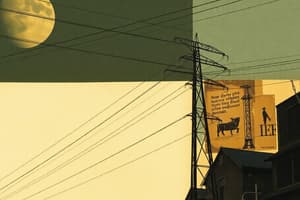Podcast
Questions and Answers
The conductors are solid ______.
The conductors are solid ______.
copper
If a long, straight cylindrical conductor lies in a uniform ______ such as air and is isolated from other charges so that the charge is uniformly distributed around its periphery, the flux is radial.
If a long, straight cylindrical conductor lies in a uniform ______ such as air and is isolated from other charges so that the charge is uniformly distributed around its periphery, the flux is radial.
medium
For ______ phase unsymmetrical spacing, the capacitance calculation is more complex.
For ______ phase unsymmetrical spacing, the capacitance calculation is more complex.
three
The ______ of transmission lines is an important consideration in power system analysis.
The ______ of transmission lines is an important consideration in power system analysis.
A ______ phase TL has flat horizontal spacing with 2 meters between adjacent conductors.
A ______ phase TL has flat horizontal spacing with 2 meters between adjacent conductors.
The conductors have an outside diameter of 3.28 cm with 12m between ______.
The conductors have an outside diameter of 3.28 cm with 12m between ______.
The radius of each conductor is 0.9 ______.
The radius of each conductor is 0.9 ______.
Calculate the capacitance to ______ per meter of a single phase line composed of two single conductor having a diameter of 0.229 inch.
Calculate the capacitance to ______ per meter of a single phase line composed of two single conductor having a diameter of 0.229 inch.
A typical transmission line has ________ as one of its principal elements.
A typical transmission line has ________ as one of its principal elements.
There are ________ types of conductors in a transmission line.
There are ________ types of conductors in a transmission line.
Solid conductors are having high ________ strength and tensile strength.
Solid conductors are having high ________ strength and tensile strength.
In homogeneous stranded conductors, ________ strands are twisted together.
In homogeneous stranded conductors, ________ strands are twisted together.
Composite stranded conductors are used to improve the ________ strength.
Composite stranded conductors are used to improve the ________ strength.
In a transmission line, ________ is used to control the voltage.
In a transmission line, ________ is used to control the voltage.
Protective devices in a transmission line include ________ and fuse cut-off.
Protective devices in a transmission line include ________ and fuse cut-off.
Supports in a transmission line include ________ poles and steel tower/steel poles.
Supports in a transmission line include ________ poles and steel tower/steel poles.
The ______ loss of a 50Km, 0.6 inch copper conductor is 150 watts at a current of 1.27A peak current.
The ______ loss of a 50Km, 0.6 inch copper conductor is 150 watts at a current of 1.27A peak current.
A 3 phase ______ line is designed to deliver 200MVA at 220kv over a distance of 63Km.
A 3 phase ______ line is designed to deliver 200MVA at 220kv over a distance of 63Km.
When a current flows through a ______, a magnetic flux is set up which links the conductor.
When a current flows through a ______, a magnetic flux is set up which links the conductor.
The ______ of a transmission line is calculated as flux linkages per ampere.
The ______ of a transmission line is calculated as flux linkages per ampere.
If permeability μ is constant, sinusoidal current produces sinusoidally varying ______ in phase with the current.
If permeability μ is constant, sinusoidal current produces sinusoidally varying ______ in phase with the current.
Flux linkages are measured in ______-turns.
Flux linkages are measured in ______-turns.
The resistivity of the ______ conductor line is 2.8x10-8Ω-m.
The resistivity of the ______ conductor line is 2.8x10-8Ω-m.
Line ______ is a key component of transmission line characteristics.
Line ______ is a key component of transmission line characteristics.
Study Notes
Components of Inductive and Capacitive Transmission Lines
- A typical transmission line consists of:
- Conductor
- Transformer
- Line Insulator
- Support (wood poles, concrete poles, steel tower/steel poles)
- Protective Device (circuit breaker, fuse cut-off, relays, ground wire, lightning Arrester)
- Voltage Control Device
- Other Equipment for voltage control System
Types of Conductors
- Mainly four types of conductors:
- Solid conductors (single piece, high mechanical strength, circular preferred)
- Homogeneous Stranded conductors (twisted together, increase current carrying capacity, easy stringing)
- Composite Stranded conductors (strands of different materials, improve tensile strength)
- Bundled conductors
Capacitance of Transmission Lines
- If a long, straight cylindrical conductor lies in a uniform medium (air), the charge is uniformly distributed around its periphery, and the flux is radial
- All points equidistant from the conductor are points of equipotential and have the same electric flux density
- Capacitance of single-phase two-wire line, three-phase line with equilateral spacing, and three-phase unsymmetrical spacing
Inductance of Transmission Lines
- When a current flows through a conductor, a magnetic flux is set up which links the conductor
- The current also establishes a magnetic field proportional to the current in the wire
- Inductance of a transmission line is calculated as flux linkages per ampere
- Flux linkages are measured in weber-turns, Wbt
- Inductance per unit length (H/m) is of interest due to the distributed nature of a transmission line
Studying That Suits You
Use AI to generate personalized quizzes and flashcards to suit your learning preferences.
Related Documents
Description
This quiz covers the components of inductive and capacitive transmission lines, including conductors, transformers, and insulators. It also deals with calculations of geometric mean radius and distance of transmission conductors.





